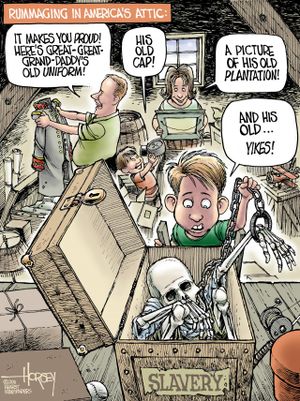Things in the attic and basement…
Good morning, Netizens...
The headline in this David Horsey cartoon reads, “Americans keep Confederates in the attic, Slaves in the cellar,” but unfortunately, the picture depicts the American family in the attic, yet the younger generation has uncovered the desiccated skeleton of a slave in the attic, not in the cellar, as the cartoon suggests. It really doesn't make any difference where we collectively uncover the skeletons of former slaves, be they in the attic or the cellar of our consciousness.
On April 12th, re-enactors dressed in Confederate gray fired cannons toward old Fort Sumter in Charleston harbor to mark 150 years since the attack that started America’s hideous war over slavery.
Four years of Civil War commemorations will now ensue and we shall see if, during the coming months, Americans, North and South (and West) can finally accept the central truth about why our bloodiest war was fought: Our country was built upon and prospered from a racist socio-economic system that could not be eradicated without blood and steel, death and destruction on an unprecedented scale.
The only substantial dispute; not states rights, not a cultural clash, not tariffs or big government — it was slavery that caused the Civil War. The Confederacy was formed to perpetuate a racist social structure more entrenched than the apartheid system in South Africa. After the war ended, Southerners did all they could to retain most aspects of that structure for another 100 years, confirming with their deeds that racial supremacy had been the impulse that brought us secession, and all the race hatred that has come to imply over the decades.
In my youth, I can remember driving long haul trucks through the Deep South and seeing, first-hand, the remaining impacts of the Civil War and later on, the continuous festering of racial strife. There were certain truck stops which, for whatever reason, catered exclusively to black truck drivers who otherwise could not eat in certain all-white restaurants; there were many truck stops that proudly flew the Confederate flags atop their flag poles out front as a warning and guideline. I never was refused service at any of the all-black truck stops, but I heard of black truckers who were discouraged from asking for service at some proudly-Confederate-leaning truck stops and I was young and naive enough to eventually make up my own mind where I would stop.
I am too old now to drive those byways and highways I once traveled. However, I still can recall vague memories of ancient and delicate places in my heart, where I often as not would find a different view of the battle of racial strife in America. Sometimes, particularly in the early morning, when I once was anxious to be off and on my way after a hearty breakfast and bottomless pots of coffee, often as not served by women of color, I still wonder if those places exist on some intercultural road map today.
Perhaps if those villainous Confederate flags no longer are flying above truck stops in the South, the Confederate War is truly over. Of course, your results may differ.
Dave
